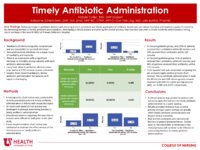The Graduate Nursing Project collection includes Doctor of Nursing Practice (DNP) Scholarly Projects and Master's students' non-thesis projects submitted as part of program requirements.
TO
1 - 25 of 14
| Title | Creator | Date | Description | Relation Is Part Of | ||
|---|---|---|---|---|---|---|
| 1 |
 |
Timely Antibiotic Administration | Collier, Natalie | 2019 | POSTER | Graduate Nursing Project, Doctor of Nursing Practice, DNP |
| 2 |
 |
Timely Antibiotics Administration: Impact of Clinical Process on Barriers Delaying Time to Antibiotic Administration in Septic NICU Patients | Collier, Natalie | 2019 | A retrospective chart review identifying potential barriers to timely antibiotic administration was performed on 51 individual patients who presented with clinical sepsis in 2017- 2018. Prior to the education and implementation of the clinical process in Fall 2018, a survey was conducted to obtain a... | Graduate Nursing Project, Doctor of Nursing Practice, DNP |
| 3 |
 |
Sepsis Bundle Compliance in the Emergency Department | Wilson, Teya; Johnson, Linda | 2021 | POSTER | Graduate Nursing Project, Doctor of Nursing Practice, DNP, Acute Care, Poster |
| 4 |
 |
Assessing the Feasibility of the Use of the Critical-Care Pain Observation Tool Versus Non-Verbal Pain Scale in the Cardiovascular Intensive Care Unit and Surgical Intensive | Hunt, Sara | 2020 | Background: Accurate pain assessments in critically ill, mechanically ventilated patients can be difficult to obtain. The current pain assessment tool to assess pain in these patients at this medical facility is the Non-Verbal Pain Scale (NVPS). This pain scale uses vital sign variation as a compone... | Graduate Nursing Project, Doctor of Nursing Practice, DNP, Acute Care |
| 5 |
 |
Assessing the Feasibility of the Use of the Critical-Care Pain Observation Tool Versus Non-Verbal Pain Scale in the Cardiovascular Intensive Care Unit and Surgical Intensive | Hunt, Sara; Terry, Kimberly; Kang, Youjeong | 2020 | POSTER | Graduate Nursing Project, Doctor of Nursing Practice, DNP, Acute Care, Poster |
| 6 |
 |
Mock Codes: A Quality Improvement Project | Memmott, Jacob | 2020 | Background: Code blues are one of the most intense, stressful, and mistaken prone situations in all of healthcare (Hatley, Jordan, Powers, & Morton, 2019). In the long term acute care hospital (LTAC) setting, very sick patients are cared for, but not many code blue emergencies occur. Therefore, clin... | Graduate Nursing Project, Doctor of Nursing Practice, DNP, Primary Care FNP |
| 7 |
 |
Implementing a Minimal Stimulation Guideline to Decrease the Risk of Intraventricular Hemorrhage | Tingey, Cameron L. | 2019 | Background: Intraventricular hemorrhage (IVH) is a significant cause of mortality and morbidity in preterm infants. It is a condition most often affecting infants born less than 32 weeks' gestation, and more likely occurring with decreasing gestational age. The majority of IVH occurs during the firs... | Graduate Nursing Project, Doctor of Nursing Practice, DNP |
| 8 |
 |
Brain Code: A Standardized Response to a Neurological Emergency | Szemak, Erin | 2017 | Intracranial hypertension (IH) is a neurological emergency that can lead to profound disability and death and is consequently referred to as a brain code. Intracranial hypertension is the sequelae of typical acute care diseases or injuries such as stroke, traumatic brain injuries (TBIs), and hepatic... | Graduate Nursing Project, Doctor of Nursing Practice, DNP |
| 9 |
 |
Improving Adherence to an Existing Protocol for Infants at Risk for Hypoglycemia | Wright, Rachel | 2020 | Background: Prolonged hypoglycemia and delays in treatment correlate with poor neurological outcomes and developmental delays in infants. Research shows that infants at risk can be managed successfully with proactive intervention and management until their bodies have compensated. Protocols enhance ... | Graduate Nursing Project, Doctor of Nursing Practice, DNP, Neonatal |
| 10 |
 |
Development of Multiple Trauma Activation Training for Surgical Services | Rachael, Hubertz; Guo, Jia-Wen | 2023 | Background: Mass casualty incidents (MCIs) create a large influx of patients, are becoming more prevalent, and require adequate training for healthcare personnel. Multiple Trauma Activation (MTA)- specific protocols promote awareness and effective responses and increase access to healthcare. Intermo... | Graduate Nursing Project, Doctor of Nursing Pract, DNP; Adult Gerontology/Acute Care |
| 11 |
 |
Code Stroke: Effects of a Protocol Revision: A Quality Improvement Project | Graham, Patrick J. | 2018 | Introduction: Acute strokes in the inpatient setting comprise 6-15% of all strokes annually and are associated with worse functional outcomes and a larger financial burden than those with outpatient onset (Blacker, 2003; Cumbler, 2015; Bekelis, Missios, Coy, & Mackenzie, 2016). Approximately 32,000 ... | Graduate Nursing Project, Doctor of Nursing Practice, DNP |
| 12 |
 |
Improved Screening of Suicidal Patients in the Emergency Room on Maui | Bentley, Joshua R. | 2019 | Psychiatric patients who present as suicidal in the main rural emergency room on Maui are not being evaluated with a standard and reliable screening tool. This creates unreliable admission criteria and inconsistent outcomes for patients. Several patients who would have benefitted from admission were... | Graduate Nursing Project, Doctor of Nursing Practice, DNP |
| 13 |
 |
Identifying Strategies to Decrease ED Boarding | VansCoy, Darrin | 2017 | Keeping patients in the emergency department (ED) after an admission decision has been made, also known as ED boarding, leads to ED overcrowding. Boarded patients continue to use ED resources and prevent new patients from being seen. Boarding can also have adverse effects, such as higher mortality r... | Graduate Nursing Project, Doctor of Nursing Practice, DNP |
| 14 |
 |
Can a Rural Hospital Reliably Preform an Emergency Caesarean Section in Less Than Thirty Minutes? | Rasmussen, Dixie Shaheen | 2017 | This project was designed to identify and evaluate key challenges a rural hospital has in providing a reliable best practice response, analyze newborn outcomes and disseminate findings to other rural hospitals that might be challenged when confronted with an Emergency Caesarean Section (ECS). Rural ... | Graduate Nursing Project, Doctor of Nursing Practice, DNP |
1 - 25 of 14
